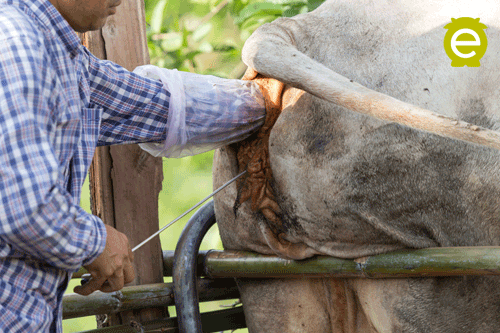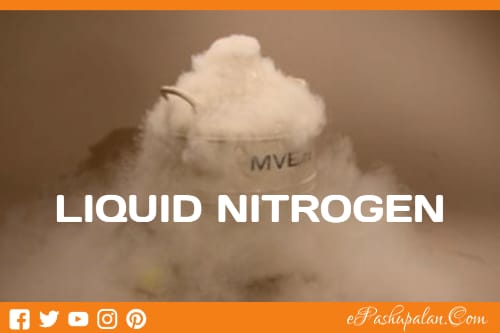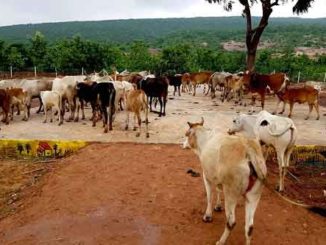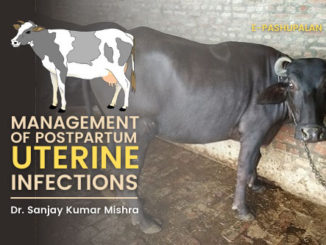Artificial Insemination (AI) is the technique in which deposition of artificially collected semen which is evaluated and extended in a suitable extender, in to the right place of female genital tract at proper time(standing estrus) by sterilized mechanical device under hygienic conditions. First AI in India is done by Dr. Sampat Kumaran at Palace Dairy Farm Mysore in 1939. He used HF semen to cross Hallikar cows and got 33 positive results. In 1942 a pilot project under Dr. P. Bhattacharya at Indian Veterinary research Institute (IVRI) Izatnagar Bareilly was started to study the feasibility of the AI in India.
Principles to be adopted while inseminating cattle and buffaloes
- Insemination should always be preferred at least 10 to 12 hours before ovulation.
- Optimum time to inseminate a cow is between 6 to 18 hours after onset of estrus.(standing estrus).
- Good quality semen, proper handling of semen, sound reproductive health of cow, general hygiene and A.I. at proper time is must to obtain high fertility rates. The later is extremely important.
- The estrous cycle length in primiparous cattle & buffaloes is 18 to 19 days, while in pluriparous cattle and buffaloes is 21 to 23 days.
- Duration of estrus (heat) ranges from 8 to 24 hours and occasionally it may be 36 hours.
- It is optimum to inseminate the animals in the second half of mid heat and first half of late heat to obtain high pregnancy rate in cattle and buffalo.

Things to be Checked before Insemination
- If the animal to be inseminated is heifer, check its body weight , which should not be less than 240 to 250 kg at the time of first service.
- There should not be any abnormal discharge from genital organs .
- The animal should not be a problem breeder, such type of animals should be treated first and then inseminated.
- Proper rectal examination should be done specially for pregnancy before insemination.
- Animal must be thoroughly examined for true heat at the time of insemination.
- There should be a gap about 60 days after normal calving and of 90 days after abnormal calving(e.g. retained placenta, abortion, dystocia, prolapse)
- The type of semen used should be decided in advance.
- If an animal is presented to the hospital or A.I. center, the animal should be properly restrained in the Travis/ crush. If the A.I. is to be performed at the door step of the farmer, then the animal is restrained with the tree or any best possible facility available with the farmer to restrict the body movements.
- If the above things are not checked prior to insemination, there are chances that the semen may go waste or there may be problems during calving.
Technique of Artificial Insemination
- Animal is restrained properly; cleanliness is most essential at the time of A.I., vulvar lips are preferably washed with 1:10,000 potassium permanganate (Kmno4) solution or similar antiseptic solution { because unhygienic insemination can carry dung and dust particles along the anterior end(tip) of A.I. gun which can cause uterine infection} & wiped dry with cotton or paper towel or clean cloth. Then vulvar lips are opened and lifted up slightly by an assistant and A.I. gun is passed through vulvar lips, which invariably reach the external os.
- To avoid the possibility of entering the urethral opening on the floor of the vagina, insert the inseminating gun in to the vulva at a 300to 400 angle.
- The procedure being added by holding the cervix per rectum with one hand, pushing it away from you as for as possible (to avoid the vaginal fornix) and passing the A.I. gun prevaginal into the cervix as for as it will go.
- The cervix is then fed gently on to the insemination gun/catheter by the hand holding the cervix within the rectum.
- The fore-finger within the rectum then establishes that the tip of the A.I. gun is in the uterine body so reducing any scraping of the endometrium and ensuring expulsion of the semen into the body of the uterus giving it equal chance to flow up both cornua.
- A similar procedure is carried out for inserting a catheter to wash-out the uterus when it is contaminated with pus.
- The anterior portion of the vagina, termed the fornix vagina, tends to stretch rather easily when the A.I. gun is pushed forward and beyond the cervix. This may give false impression that progress is being made in advancing the gun through the cervix when indeed it is above, below or to either side of the cervix.
- However, one should be able to feel the A.I. gun within the vaginal fold. When the A.I. gun is within the cervix the tip of A.I. gun cannot be felt.
- Remember; place the cervix on to the A..I. gun. Maintain slight forward pressure on the A.I. gun while the cervix is manipulated slightly ahead of the A.I. gun.
- The target for semen deposition is the uterine body. The target is quite small. Accurate, placement of the tip of A.I. gun is probably the most important skill involved in the whole A.I. technique generally veterinarians identify this target area by feeling for the end of the cervix and the tip of the rod as it exits through the internal os or opening.
Guidelines for Artificial Insemination
- The clinical signs such as mounting on other animal(s)/ person(s) is generally seen in early heat.so it is better to inseminate these animals 5 to 8 hours later. Note:- however, if owner demands insemination in early heat, it is preferable to deposit the semen intra cervically rather than intra uterine. Because the sperms deposited intrauterine get capacitated earlier than sperm deposited intra cervically.
- Animal that come to A.I. center should be rested for 15 minutes before examination or A.I. because animal get excited while coming to A.I. center due to dragging/ beating/ sound produced by vehicle. Excitation causes release of adrenaline which interferes with the sperm transport.
- The uterine horn should be tonic and coiled, during estrus , if not tonic the animal is not in estrus. If uterus is atonic in the beginning after the examination of each horn from base to tip and vice versa and if tonocity improves it is considered to be infected and A.I. is not advised.
- The diameter of each horn from its dorsal to ventral curvature should be examined, if diameter is more than 3.5 cm, it suggest uterine infection/ pregnancy/ uterus is not involuted following calving or abortion. The difference between the two horns should limit to half a centimeter, in normal healthy genitalia.
- In some animals, the tubularity of horns may be round but the consistency may be soft and if squeezed gently the uterine horn from tip to base, if they become flat or bi-concave the animal may be having second degree endometritis.
- NOTE:- In some animals during heat, the mucous discharge in blood mixed( even blood clots may be observed) and when uterine horns are gently squeezed from tip to base, if they do not become flat, A.I. can be done and advised to feed 250 to 500 gram extra oil cake daily, If uterus flattens, then it requires intrauterine treatment
- By gentle squeezing of uterus, a clear discharge is observed, if it, is cloudy or dirty in nature, no A.I. is recommended. The mucous discharge is examined under microscope(without staining)if it shows more than 8 WBCs per high power field, it is considered to have 1st degree endometritis and A.I. is not advised.
- The consistency of uterine horn should be meaty(normal) but not hard or soft. The consistency of buffalo uterus is more hard as compared to that of cattle. Soft consistency of uterus is palpable during uterine infection or under feeding causing lack of sufficient blood supply to uterus. A.I. is contraindicated in soft consistency of uterus. Hard consistency of uterus may be seen in highly tonic uterus or it may be as indurated uterus.
- Examine the ovaries carefully to confirm the regression of C.L. and to appreciate the development of follicle. Follicle will be tough in early stage, which become soft during mid- heat and more soft in late heat and flexible after late heat.
- NOTE:- In buffaloes, the follicle is more fragile and rupture more easily as compared with cattle during examination, hence cautious examination is advised.
- Frozen semen is stored in liquid nitrogen(LN2) container at -196° C in a goblet or a sub goblet of a container. The distance between the top end of the semen straw and the mouth piece of the container should be minimum of 8 to 10 cm. so that the straw is maintained at minimum -72° C where the sperms will be in frozen state. If the goblet/ sub goblet is lifted higher specially in sufficient quantity of LN2 is not there in the goblet, the straws are exposed to room temperature. Repeated exposures can lower the fertility due to seepage of certain essential enzymes from sperms hence, it is advised to use a long forceps to lift the individual straw from the goblet/ sub-goblet.

- The straws should be surrounded by liquid nitrogen through the transferring procedure and storage time.
- Deep frozen semen straws should be thawed at 37° C ± 1° C. for 30 sec (French mini straws) or 60 sec(French medium and German mini straws). To cold water container, warm water is added and the temperature must be checked with a clinical thermometer.
- It is preferred to carry the semen in LN2 container (small) or the thawed semen is carried in thermos flask and used for insemination within 30 to 60 minutes after thawing.
- The thawed semen straw has to be wiped with a clean cloth/ towel, since even a small drop of water can cause the sperms to get their tails coiled and results in lowered fertility
- The semen straw has to be opened at the laboratory seal end and not at the factory seal end (only for French straws). The straw should be cut perpendicular to its length.
- Animal should not be excited 15 minutes prior to , during or 15 minutes after A.I. Excitation causes the release of adrenaline and suppress the action of oxytocin which is required for sperm transport.
- The semen should be slowly deposited from the straw in to cervix (in early heat), while in late mid heat or early late heat the entire quantity of semen is deposited in the body of uterus or into the uterine horn having that side a mature follicle in the ovary or half the semen may be deposited in the uterine body and the other half in the cervix.
- While A.I. gun is being withdrawn out of uterus , first hand is removed from the rectum of the animal, followed by the withdrawal of the A.I. gun, while the A.I. gun is being withdrawn its tip should be made to glide over the “clitoris” which helps in the release of oxytocin for sperm propulsion.
- Cold water can be poured on the back of the animal which can cause abdominal muscle contraction and in turn uterine muscles and helps sperm transport
- Rest for 15 minutes is necessary after A.I. so that the sperms can reach the utero-tubal junction (within 5 to 10 minutes after deposition sperm can reach utero-tubal junction during estrus)
- The A.I. gun has to be examined to note any blood tinge or pus on the tip of A.I. gun. Sometimes the semen might have flown back between the A.I. sheath and straw, in such cases re- insemination is advised.
- The owner has to be advised to examine the mucosa of vulval lips of the animal daily for “next three days” to notice any pus flakes, which is an indication of 1st or 2nd degree endometritis and such cases should be treated accordingly
- Some heifers and cows may secrete blood mixed discharge 1 to 3 days following estrus. On the day of such bleeding the owner should be advised to produce the animal for examination of ovulatory disturbances or for uterine infections
Reference:
- Veterinary Reproduction and Obstetrics Tenth edition(2019) . David E. Noakes, Timothy J. Parkinson and Gary C. W. England
- Diagnosis and Treatment of Reproductive Disorders in Dairy Cows(Theriogenology-I) First edition (1994) Dr. V. N. Viswanatha Reddy
| The content of the articles are accurate and true to the best of the author’s knowledge. It is not meant to substitute for diagnosis, prognosis, treatment, prescription, or formal and individualized advice from a veterinary medical professional. Animals exhibiting signs and symptoms of distress should be seen by a veterinarian immediately. |






1 Trackback / Pingback